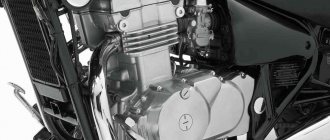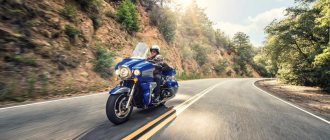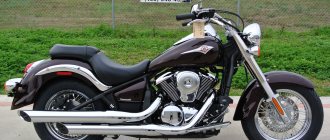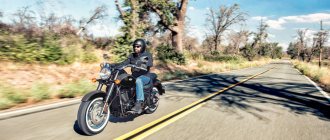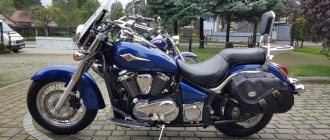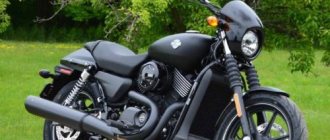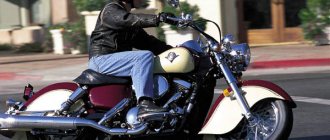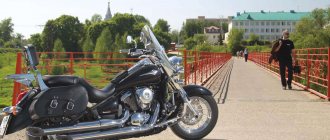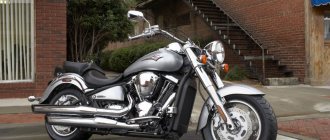It shines, roars and asks to go... Having gotten rid of the shortcomings of the EN 400, it is ready for new achievements and does not tolerate compromises. We are, of course, talking about the Kawasaki VN 400 Vulcan from the same legendary concern! This time Kawasaki decided to do something really impressive...
The motorcycle is a logical continuation of the EN of the same number, and outwardly even someone can confuse them. But not an experienced biker! Even the exterior itself declares: this is a beast of a completely different breed, and it has many times more ambitions!
Engine
The first distinguishing feature of the model is its engine. Four-stroke and two-cylinder, it is, however, no longer in-line, but V-shaped. Its working volume is almost 400 cubic centimeters (399). This circumstance, combined with a 15-liter tank, makes the motorcycle suitable for lovers of long trips.
The maximum speed is lower than that of the four hundredth “ancestor”, and reaches only 140 kilometers per hour, but this is more than compensated for by the increased traction! Such motorcycles don’t need too much speed; that’s what sports bikes are for.
At its peak, the torque reaches 32 nanometers, and the rpm is 4500. The highest power is 33 horsepower, the rpm is 8500.
Brief history of the model
1995 - start of production and sales of Kawasaki VN400 Vulcan. Modification - Kawasaki Vulcan II. Model: Kawasaki Vulcan 400 (Vulcan II) (Japan). Factory designation: VN400-A1, VN400-B1.
1996 - in addition to the basic version of Vulcan II, the Vulcan Classic version appears. Model: Kawasaki Vulcan 400 (Vulcan II), Kawasaki Vulcan 400 Classic (Japan). Factory designation: VN400-A2, VN400-B2, VN400-C1.
1997 - no significant changes. Model: Kawasaki Vulcan 400 (Vulcan II), Kawasaki Vulcan 400 Classic (Japan). Factory designation: VN400-A3, VN400-C2.
1998 - Classic modification is temporarily not offered. Model: Kawasaki Vulcan 400 (Vulcan II) (Japan). Factory designation: VN400-A4, VN400-B4.
1999 - the appearance of the Drifter modification. The Classic version is available again. The basic version of Vulcan II is being discontinued completely. Model: Kawasaki Vulcan 400 Classic, Kawasaki Vulcan 400 Drifter (Japan). Factory designation: VN400-C4, VN400-D1.
2000 - no significant changes. Model: Kawasaki Vulcan 400 Classic, Kawasaki Vulcan 400 Drifter (Japan). Factory designation: VN400-C5, VN400-D2.
2001 - no significant changes. Model: Kawasaki Vulcan 400 Classic, Kawasaki Vulcan 400 Drifter (Japan). Factory designation: VN400-C6, VN400-D3.
2002 - no significant changes. Last year of production of the Drifter modification. Model: Kawasaki Vulcan 400 Classic, Kawasaki Vulcan 400 Drifter (Japan). Factory designation: VN400-C7, VN400-D4.
2003 is the last year of production of the Classic modification. Model: Kawasaki Vulcan 400 Classic (Japan). Factory designation: VN400-C8.
Dimensions and weight
The motorcycle is quite large. Even in width it is 1005 millimeters. Its length reaches all of 2490 millimeters, and its height is 1125. The saddle height of the model is 760 millimeters, and the wheelbase reaches 1615. 248 kilograms allow the Kawasaki VN 400 to be classified as a heavyweight classic, making it not the most convenient option for short people with a non-athletic constitution.
Review of the Kawasaki VN 400 Vulcan motorcycle
I rode this motorcycle for 3 seasons and about 12 thousand kilometers. You can say that this is a “little mule”! The motorcycle is quite durable, well controlled due to its low center of gravity and low weight (190 kg). I was very pleased with the fuel consumption, about 3.5 liters. per 100 km. with a 15 liter tank. Brakes - single disc at the front, mechanical brake at the rear. The brakes are average, they stop well, but could be better, 3+. The motorcycle is good both in the city and on the highway.
For those who are interested in how much it is, I can say that scabies is scabies. The speedometer shows a maximum speed of 140 km/h, I set the needle on a flat road, without wind and slightly downhill. The optimal speed is 90-110, after which it accelerates poorly. It accelerates worse with a passenger, but pulls it out. But overtaking is more difficult. Overall it holds the road very well.
This model has a 5-speed gearbox, but in my opinion, 5th gear serves as cruise control to maintain speed. All acceleration after 80 km/h occurs at 4 speed.
The motorcycle looks great, a small copy of Harley. In addition, without knowing that it’s scabies, the engine looks no less than a liter in volume! Large, wide wheels, both front and rear. You walk along the cut asphalt as if you were on rails! In addition, the motorcycle is very well tuned.
The motorcycle is quite easy to maintain. Some swear by replacing spark plugs. The thing is, in order to replace the spark plug on the front cylinder you need to remove the tank, on the rear cylinder you need to remove the seat (but this is not a problem). The problem with the front cylinder is solved in the following way: the handle on the spark plug is cut off, the nut is welded and the spark plug is calmly unscrewed. With this mechanism there is no need to remove the tank.
Pros of Vulcan:
1)Easy to maintain
2)Very low gas mileage
3) Good handling
In my opinion, the disadvantages of this model (also for the eight hundred) are:
1)monoshock absorber
2) lower mount of monoshock absorber
3) low load capacity (at least for me this was a minus)
With my weight being 100 kg. I have repeatedly punched the monoshock absorber even at the maximum stiffness adjustment mark. The solution is to buy a new progressive shock absorber, which is expensive, or to install a silicone bumper on the rod (sold at any auto parts store, costs about 30 rubles), which shortens the shock absorber stroke. But it turns out to be a kind of semi-sucker. Since I was traveling with my wife, it helped a lot and only hit a couple of times on random potholes, and the suspension works fine with a passenger.
The disadvantage of the monoshock absorber mount (the so-called dog bone) is that it is located below the motorcycle frame. When I drove into the garage, I sat down on it with my belly; I had to put a board down when I arrived. Since the fastening metal is very soft, it can be licked off in no time! But in general the ground clearance is good, for example the Yamaha Dragstar 1100 is much lower.
And the third minus is the carrying capacity. With a motorcycle weight of 190 kg, the load capacity is only 300 kg. Those. I sit down and I’m already 290 kg. + spouse and luggage, approximately 370 kg. But as I said above, the motorcycle is very durable and pulled us at 100%!
In conclusion, I can say that the Kawasaki VN 400 Classic is a good, solid and durable motorcycle intended for those who are just learning to ride a motorcycle, or for those who want a cruiser/chopper, but cannot afford it in the price category. These models are very budget-friendly and cost around 140 thousand rubles. With proper care, the motorcycle will last a long time, like any other equipment!
Now I drive a vn 400 classic, sometimes the dynamics are certainly not enough, but taking into account that this is a 400 and not a sport... a cruiser of 100-110 km is quite enough in the city, I was pleasantly pleased with the consumption of 3.2-3.5 in the city, spare parts for them are not cheap . It is quite possible to maneuver in traffic jams. The steering is pleasant, and I hardly get tired after a whole day in the saddle. + appearance, no one has yet guessed that I have 400 and not 800))
I rode this for my first season.
The bike is big and solid, for a big man, you feel like you’re not on a bicycle. The weight is quite decent, 230 kg, the engine is 34 hp, this is certainly not enough for him, you’ll be the first to leave a traffic light, but on the highway it’s not enough for overtaking.
The weight is quite decent, 230 kg, the engine is 34 hp, this is certainly not enough for him, you’ll be the first to leave a traffic light, but on the highway it’s not enough for overtaking.
Very stable, handles well, forgives mistakes, which are inevitable at first. Beautiful, infectious - probably one of the best out of 400 acres (I have a Classic, with a thick front wheel)
Beautiful, infectious - probably one of the best out of 400 acres (I have a Classic, with a thick front wheel)
Regarding maintenance:
— there is only one carburetor, so there is nothing to synchronize there.
I haven’t climbed into the carb myself, so I can’t say anything about it. — spark plugs — it’s inconvenient to change the spark plug of the front cylinder, I had to come up with a little gadget to turn it out without removing the tank. The rear one can be easily unscrewed when the seat is removed.
— replacing antifreeze — no problem, the only surprise was that the radiator cap was located under the speedometer.
- changing the oil - no problem, you don’t need to remove anything for this (I read that on Dragstars the oil filter is changed with the exhaust removed)
- chain - yes, it requires maintenance, a cardan would not hurt.
— The seat is not terribly comfortable, after a hundred kilometers it gets hot on your butt and you start to fidget. However, this is subjective.
— the box is noisy, but this is a feature of all Cavs, as far as I know. The gears don't fall out, but sometimes when you're standing still you'll struggle to find neutral.
Overall, I’m very pleased with it as my first bike, I realized that the chopper is for me. In the spring I will change it to a larger cubic capacity, but the memories will remain extremely positive.
Chassis and brakes
The frame is a steel tubular body, which is designed in the best traditions of classic design. This motorcycle is not as modest as the EN 500 Vulcan. No, with all his appearance he “screams” about his own originality and power. It may seem that its appearance challenges those who are considering a purchase.
The front suspension is a telescopic fork increased to 41 millimeters, with the same travel as the EN 400 – 15 millimeters. The rear suspension has only a monoshock absorber, and it is of pendulum type. The stroke of the latter is 100 millimeters. The size of motorcycle wheels is within the framework of classical traditions. The appearance of the discs can be a source of pride for this Vulcan: there are few places where you can find such a precise and stylized design.
The steering wheel gives control and confidence. It is not too big, but allows you to sufficiently feel and control the car. The mirrors have the shape of an irregular quadrangle with an extension from the driver. A sort of middle option between modernism and old school.
The car's brakes correspond to its capabilities in terms of speed and traction: at the front there is a 300 mm disc, accompanied by a two-piston caliper; well, the rear is almost the same, only the disc diameter is 270 millimeters.
Known design issues with the Kawasaki Vulcan VN400
Despite all the simplicity and reliability, you need to take into account the age of individual motorcycles. Wire insulation and contacts do not last forever, the first cracks and collapses, the second oxidizes, and if the playful hands of a “nosy electrician” previously got into it, then sometimes it’s easier to completely change the entire harness than to deal with endless “twists”, unwinding kilometers of electrical tape.
Among the shortcomings of the Kawasaki Vulcan VN400 is the monoshock absorber, the rigidity of which is not enough even for a driver with a slightly above average weight, but usually this problem has already been solved by the previous owner, unless of course it was a fifty-kilogram Japanese.
If you find fault, then weak brakes also come under attack. And if in the Drifter version, due to the rear brake disc, the motorcycle brakes quite confidently, then in versions with a rear drum brake, we can say that there is no rear brake. On the other hand, the capabilities of the 400 cc engine are very limited, so you first need to accelerate before braking. To be objective, the lack of brakes is felt at speeds above 70-80 km/h when sudden braking is necessary.
History of changes
The model has undergone a number of modifications that have benefited it. Here's a little history of the big motorcycle:
- 1995 – the first generation appeared;
- 1996 – Vulcan Classic version released;
- 1998 – Classic does not enter the market;
- 1999 – return of the Classic and appearance of the Drifter;
- 2003 – end of production of the model and modifications.
For one reason or another, the Kawasaki VN 400 Vulcan could not stay afloat as long as the EN 500 did. Nevertheless, the model was a great success, and many connoisseurs of the concern’s products and the classic “steel horse” will be happy to buy this wonderful bike, if they come across such a proposal.
Development of Kawasaki Vulcan VN400
The motorcycle is presented in 4 variants, although in fact there are 3 of them. Their designation is as follows: the basic version is designated by the letters A and B after VN400 (produced from 1995 to 1999); the letter C denotes the “Classic” version (produced from 1996 to 2003 with a break in 1998); the designation with the letter D is for the “Drifter” modification (produced from 1999 to 2002).
Visually distinguishing modifications from each other is as easy as shelling pears. The Classic differs from the basic version by having a 16-inch front wheel instead of a 21-inch one. The version with the designation “Drifter” had a disc rear brake instead of a drum rear brake, a 2-in-1 exhaust, you can also focus on the absence of a passenger seat and wide fenders. The modifications themselves did not undergo significant changes during the production process.

